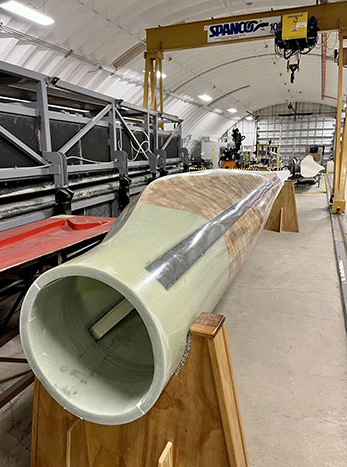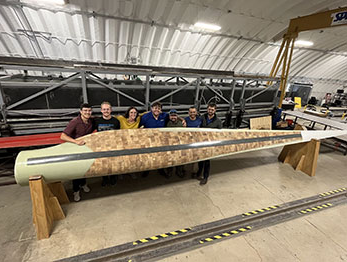Recyclable, plant-based glue cuts carbon footprint of Wind Mills – Energy Put up – Google

 Everyone is aware of that wind and solar luxuriate in indispensable carbon footprints due to the the energy and materials that wander into the luxuriate in of their parts. It’s why examine continues on salvage that footprint down. Emily Mercer at NREL describes examine there that has developed a glue, used to personal a wind turbine blade collectively, fabricated from resin fabricated from plant smash the usage of a low-energy process, and is without complications recycled. In incompatibility to basically the most stylish glues fabricated from non-renewable resources (like petroleum), the unique PECAN resin produces 40% fewer emissions and requires 30% much less energy to create. The structural performance is the identical or, in some cases, better. The process for recycling the PECAN resin is easy and also will most most likely be performed on the wind farm decommission build. The subsequent step is to measure its performance on very mountainous blades.
Everyone is aware of that wind and solar luxuriate in indispensable carbon footprints due to the the energy and materials that wander into the luxuriate in of their parts. It’s why examine continues on salvage that footprint down. Emily Mercer at NREL describes examine there that has developed a glue, used to personal a wind turbine blade collectively, fabricated from resin fabricated from plant smash the usage of a low-energy process, and is without complications recycled. In incompatibility to basically the most stylish glues fabricated from non-renewable resources (like petroleum), the unique PECAN resin produces 40% fewer emissions and requires 30% much less energy to create. The structural performance is the identical or, in some cases, better. The process for recycling the PECAN resin is easy and also will most most likely be performed on the wind farm decommission build. The subsequent step is to measure its performance on very mountainous blades.
About three years ago, Nationwide Renewable Energy Laboratory (NREL) researchers Robynne Murray, Nicholas Rorrer, and their team location out on a mission to create an without complications recycled resin to support as the central glue conserving a wind turbine blade collectively.
They started by formulating their resin in thimble-sized vials on the lab bench. And after a whole lot of rounds of experimenting, comely tuning, and slowly scaling up, the team successfully used their unique resin to set aside a 9-meter prototype wind turbine blade (the scale of a volleyball fetch)—marking a indispensable milestone in the direction of the subject subject’s readiness for mainstream manufacturing.
PECAN: PolyEster Covalently Adaptable Community
Nicknamed PECAN, the unique resin boasts a novel composition, nonetheless it’s some distance neither flavoured nor made with its nutty namesake. As an different, the title is an acronym representing the subject subject’s chemical structure (PolyEster Covalently Adaptable Community). The researchers designed the PECAN resin the usage of biobased chemicals that would possibly perchance also be without complications extracted from plant smash.
The recyclability advise
Now, you will most most likely be in a position to be thinking, “What’s the level of the usage of plant smash to create a wind turbine blade?”
The answer lies in sustainability and recyclability.
Bigger than 70,000 wind generators are currently working within the US, and that quantity is anticipated to develop vastly as the nation speeds up in the direction of a excellent-attempting energy future. Truly, it’s some distance estimated that extra than 2 million a total bunch wind turbine blade materials will most most likely be deployed within the US by 2050.
Traditionally, most resins used in wind turbine blades require non-renewable resources (like petroleum) and loads of of energy to create. Additionally they’re advanced or not doubtless to recycle tag successfully and without vastly degrading the subject subject.
To decarbonise the energy sector and salvage rid of smash, the wind energy industry needs a brand unique, sustainable solution.
Then over again, as it looks to be, rising resins which shall be sturdy and without complications recycled would possibly perchance also be a tough nut to crack. But the NREL team is proving they’re up for the project with the PECAN resin.
Sustainable from the birth
The PECAN resin would possibly perchance also be made fully from biobased materials, like sorbitol, a accepted sugar that would possibly perchance also be chanced on in plant smash.
But PECAN-based wind turbine blades luxuriate in the relieve of extra than factual inexperienced constructing blocks. The process to luxuriate in a blade with PECAN resin is greener, too.

A recyclable, plant-based resin developed by NREL researchers would possibly perchance perchance relief originate a sustainable solution for the wind turbine industry, like this 9-meter prototype blade. / IMAGE: Robynne Murray, NREL
The NREL team showed that the PECAN resin produces 40% much less greenhouse gasoline emissions and requires 30% much less energy to create when compared to the epoxy basically used in on the novel time’s U.S. wind turbine blades.
“This is titanic,” Murray acknowledged. “It creates the skill to construct indispensable energy and money while moreover decarbonising the first lifetime of every turbine.”
Constructed to last
No subject how sustainable a wind turbine blade is, the last ingredient it would possibly perchance perchance perchance well be is flimsy. That’s the reason the NREL team created the PECAN resin to expose the identical—or, in some cases, better—structural performance compared to on the novel time’s wind turbine blade materials.
As an instance, the unique subject subject outperformed former resins within the “lunge” department. Contain no longer scare. Spin, on this occasion, is no longer a measure of the quantity of spiders crawling on the blade. Pretty, the term signifies how wisely a blade holds its stiffness over time.
“If a wind blade hangs out within the air below its beget weight for lengthy enough, you can perchance well question it birth to lose its stiffness. And that’s basically a truly mountainous advise with other resin systems,” Murray acknowledged.
“And thanks to its weird and wonderful chemistry,” Murray persisted, “we’ve been in a position to notify the PECAN subject subject performs truly wisely on lunge assessments.”
Readily recyclable
Treasure factual about anything, wind generators set aside no longer last without a sign of ending. And after they’ve reached the stop of their working lifestyles, recycling their parts is the biggest section of constructing a sustainable wind energy industry.
The PECAN resin moreover hits the stamp within the recyclability class. Producers can depolymerise it (or ruin it down) the usage of minimal energy or instruments and no harsh or depraved chemicals.
“This implies blades made with the PECAN resin luxuriate in the skill to be recycled on the wind farm decommission build, which would possibly perchance minimise blade transportation emissions and additional decarbonise the lifestyles cycle of every turbine,” Murray acknowledged.
Pointless to snort, right here’s no longer a twist of fate. The NREL team fastidiously designed the resin to consist of a community of particular chemical bonds (known as ester linkages), which would possibly perchance also be broken down with obtain and cheap chemicals, contributing to the convenience of recycling the subject subject.
Made imaginable in a one-of-a-type lab
Murray notorious that the examine on the help of PECAN resin became once made imaginable due to the NREL’s one-of-a-type examine resources and facilities, like the Composites Manufacturing Training and Expertise Facility.
“At NREL, now we luxuriate in all the pieces from professional biopolymer scientists to cutting-edge work testing capabilities all in a single converse,” Murray acknowledged. “This has allowed us to streamline the full examine process, taking this resin from conceptual chemistry to an steady blade in honest just a few years, which is barely exceptional!”

The NREL team plans to set aside a wiser wind turbine blade than this 9-meter one with their PECAN resin so that they would possibly perchance perchance make additional structural experiments. / IMAGE: Miguel Gonzalez Montijo, NREL
Subsequent, the team plans to luxuriate in an even bigger blade with the PECAN resin, which would possibly perchance enable them to make additional structural experiments sooner than the resin is market ready.
If all goes wisely, the team is hopeful their resin would possibly perchance also be a easy tumble-in replace for most stylish wind turbine materials. And that would possibly perchance perchance well very wisely be an answer the wind energy industry is hasten to acquire appetising.
Learn extra about NREL’s unique wind turbine materials examine, and take a look at the Manufacturing Mastermind Sequence to read the stories of the individuals on the help of this work.
***
Emily Mercer is an Energy Diagnosis Writer and Communications Challenge Manager at NREL
This article is published with permission from the Nationwide Renewable Energy Laboratory


